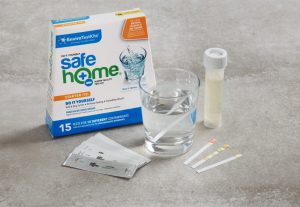Even though municipal treatment facilities do an excellent job of ensuring that the general water supply is suitable for human consumption as a whole, there are certain crucial circumstances in which an individual must perform their own testing of the water supply.
Testing the quality of your water will give you the required information for developing the appropriate treatment strategy for a routine inspection of your water.
Why Do You Need To Test Your Water?

Performing a water quality test can be beneficial. It is because consuming polluted water can significantly threaten your health. So, water testing is required.
If you do not test your water and let untreated water go through your system, it might cost you a lot of money and necessitate repairs in the long run.
Additionally, installing a water purification system without having proper knowledge of the water quality can result in unnecessary costs, damage to the normal water system, or, even worse, ineffectiveness in preventing the spread of harmful contaminants. Because of this, a water quality test must be performed.
Let’s move on and try to find out the answer to one common question; how to test water for bacteria at home and discuss all the water quality tests you can do at home without a kit.
1. Assess The Color, Taste, And Odor Test
Hard water may be identified in the water supply by color, odor, or taste. The process of detecting problems, which is the first step in the process of mitigating them, can be challenging since it can be difficult to define the particular origins of odor, color, or flavor anomalies.
If you are uncertain about how these qualitative aspects affect your existing water supply, you should compare the quality of your tap water to that of one of the cleanest water products available on the market, which is bottled or distilled water.
Although even the most thoroughly distilled water products do not contain pure water, you may use it as a reference point for the quality of the water in your home because it is a neutral substance.
If you want to determine whether or not your tap water‘s odor, color, and flavor are satisfactory, compare each measure to what you find in distilled water samples.
In comparison to the distilled water used as a control, if the drinking water that you have at home has an odd smell, color, or flavor, then the supply of drinking water that you have at home may be polluted.
2. Use A Water Hardness Test
Hard water may also exist in municipal water systems, even though it is more typically associated with private water sources such as a well.
The amount of calcium, potassium and iron that are dissolved in the water supply determines the water’s hardness. Other dissolved minerals can also contribute to water hardness.
Even though hard drinking water probably won’t kill you, if you don’t treat it first, it might end up costing you a lot of money to fix the problems it causes in the water system. The presence of hardness in the water can lead to the formation of calcium deposits in the pipes, valves, and showerheads.
Testing the water supply to determine its hardness will provide an exact measurement of the elements that are already present in the water. This can assist in determining the most effective method for lowering the water’s hardness.
One of the most convenient methods for testing the hardness of your water is to use a transparent, clean, empty water bottle with a lid, pure liquid soap, and water directly from the faucet. This method does not require you to go too far from your normal routine.
After filling the bottle two-thirds of the way, add a few drops of pure laundry detergent and give it a good vigorous shake for a few seconds. Hard water may be identified by the noticeable absence of puffy bubbles and by the hazy or milky appearance of the water. If this describes your water supply, then your water is likely hard.
3. Try A Magnifying Glass

While it’s true that not all contaminants can be seen with the naked eye, using your other senses is still essential for identifying and addressing water quality concerns.
To examine the water in more detail with a magnifying glass, fill the vessel with water, position it so that it is illuminated by strong light, and then use a magnifying lens on the water.
There is a possibility that the water in your house is polluted if you observe cloudiness, froth, or floating particles that persist for longer than a few minutes.
Establishing a benchmark for visual water clarity can assist you in determining the efficacy of any water purification solutions you test out to improve the water quality in your home.
4. Boil Your Water For A Dissolved Solids Test
The term “total dissolved solids” (TDS) refers to the various organic and inorganic compounds, such as minerals and ions, that are dissolved in water to a specific degree. These materials can be found in water. The water may pick up particles off stones, pipelines, and other surfaces as it travels through them.
This causes the water to become more complex. The total dissolved solids (TDS) in water can originate from various places, including the minerals contained in the water-treatment chemicals, the runoff from roadway salts, and the pesticides or fertilizers used on farms. So, to check the total dissolved solids in water at home, you must do the following steps.
- Clean and dry appropriate cooking vessels, such as a pan or pot.
- Put a cup of water inside the pan.
- Put the pan on the stovetop and bring the water to a boil without covering it. Wait until it reaches the boiling point.
- Once most of the water has evaporated, you may turn off the heat.
- Hold off until the pan has reached room temperature.
- Then check the pan bottom; if you find any creamy or chalky substance, ensure that your water has a lot of dissolved solids.
Why Test Your Home’s Water Quality?

Testing your water may help you uncover any frequent problems that may be innocuous but still impact the flavor and quality of the water. Testing water also has an additional benefit that it gives you mental satisfaction that your water is safe to drink.
Some contaminants in the water supply have been linked to various adverse health effects, including digestive diseases, reproductive issues, and neurological conditions.
Furthermore, infants, young children, pregnant women, the aged, and those with compromised immune systems may be at an increased risk of becoming unwell if the water quality is compromised.

